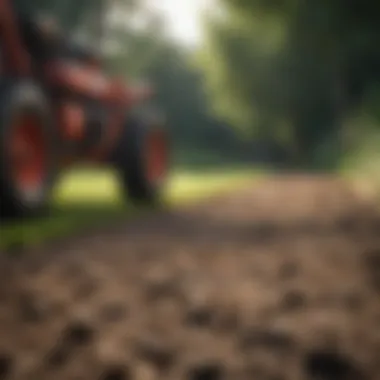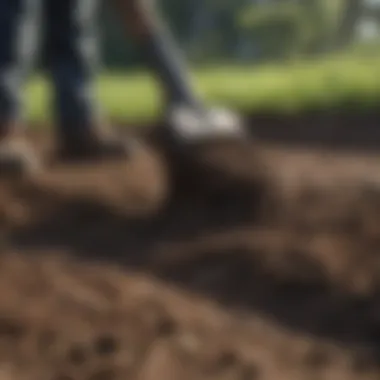Master the Art of Lawn Leveling with Topsoil


Intro
Leveling a lawn is a crucial gardening task that many homeowners overlook. A level lawn is not only visually appealing but also promotes healthier grass growth. Uneven terrain can create drainage issues, leading to water pooling, which is not ideal for grass health. In this guide, we will explore how to use topsoil effectively for this purpose.
To begin with, understanding key concepts and terminology related to lawn leveling is essential. This knowledge not only informs the process but also helps in communicating effectively about common issues that can arise with uneven lawns.
Key Concepts and Terminology
Basic Definitions
Lawn leveling refers to the process of redistributing soil to create a flat surface. Topsoil is the uppermost layer of soil, often rich in nutrients, making it suitable for this task. Other terms you may encounter include:
- Grading: Adjusting the slope of the land to promote drainage.
- Compaction: The process of packing soil to enhance its stability.
Historical Context
Lawn care has evolved significantly over the decades. In the past, homeowners relied on simple tools and manual labor to maintain their lawns. However, the introduction of modern machinery and soil treatments has transformed how people approach lawn aesthetics. Understanding this historical context can help us appreciate the methods and tools available today.
Recent Innovations and Trends
Technological Advancements
The field of lawn care has seen several innovations. Tools such as laser leveling devices and soil moisture sensors help determine the fertility and overall condition of the lawn. These technologies allow for a more precise and effective leveling process, minimizing waste and maximizing efficiency.
Sustainable Practices
Sustainability has become a core principle in agriculture and landscaping. The focus has shifted towards using organic topsoil and natural amendments rather than synthetic fertilizers. This not only protects the environment but also aligns with the growing demand for eco-friendly landscaping practices.
Practical Applications and Techniques
Step-by-step Guides
Now, let us explore a step-by-step approach to leveling your lawn using topsoil:
- Inspect the Lawn: Walk around your yard and identify uneven areas. Look for low spots and record their locations.
- Measure the Area: Knowing the size of the lawn will help you calculate how much topsoil you'll need.
- Choose the Right Topsoil: It's essential to select quality topsoil that is nutrient-rich and suitable for grass growth.
- Apply the Topsoil: Spread the topsoil evenly across the uneven areas. Use a rake to level it out further.
- Water the Lawn: After application, watering helps to settle the topsoil and encourages grass growth.
Remember, consistency in watering is key to the successful establishment of new soil.
Case Studies
Consider a homeowner in Ohio who neglected regular lawn upkeep. By applying the steps above, they observed significant improvements within weeks. Their lawn became more uniform and drainage issues improved dramatically. This example illustrates the effectiveness of proper lawn leveling techniques.
Foreword to Lawn Leveling
Lawn leveling is a crucial practice that enhances both the aesthetic value and the health of a lawn. Understanding its significance is essential for anyone looking to maintain a beautiful outdoor space. An uneven lawn can lead to various problems, such as poor drainage, uneven growth of grass, and even pest infestations. Hence, knowing how to level a lawn properly can mitigate these issues and contribute to a thriving landscape.
Defining Lawn Leveling
Lawn leveling refers to the process of correcting surface irregularities of the lawn. This can involve filling in low spots, reducing high spots, and ensuring an even distribution of soil across the landscape. It’s not merely a cosmetic improvement; lawn leveling plays a vital role in promoting even water distribution and healthy grass growth. When done correctly, it leads to a more inviting and functional outdoor area.
Benefits of Leveling a Lawn
There are numerous benefits to leveling a lawn. Some of the key advantages include:
- Improved Drainage: Leveling helps prevent water pooling in low areas, which can cause problems like mold and grass death. Proper drainage is essential for both the health of the soil and the grass.
- Enhanced Aesthetic Appeal: A uniform lawn is visually pleasing, creating a perfect backdrop for landscaping and outdoor activities.
- Facilitated Lawn Care: An even surface allows for easier mowing, watering, and maintaining the grass. This reduces the time and effort required for lawn care.
- Promotion of Grass Health: Leveling helps ensure even sunlight exposure and water distribution, facilitating healthy growth across the lawn.
Understanding Topsoil
Topsoil is a crucial component in the process of leveling a lawn. Its properties influence both the immediate outcomes of lawn leveling and the long-term health of your grass. It is important to understand what topsoil is, its nutritional content, and how its quality affects soil health. This knowledge helps in making informed decisions necessary for a successful lawn leveling project.


What is Topsoil?
Topsoil is the uppermost layer of soil, typically ranging from two to eight inches deep. It is the most fertile and biologically active part of the soil profile. Topsoil forms over time through the weathering of minerals and the decay of organic matter. In landscapes, it contains a mix of clay, silt, sand, organic matter, and microorganisms. This mixture is what makes it so beneficial for supporting plant life, particularly lawns.
When undertaking lawn leveling, having an adequate layer of topsoil ensures that grass roots have essential access to nutrients, air, and water. The quality of the topsoil can directly influence the establishment and growth of grass after leveling, making it vital to select appropriate topsoil for the task.
Nutritional Value of Topsoil
The nutritional value of topsoil is a defining feature that influences plant health. Topsoil is often rich in essential nutrients such as nitrogen, phosphorus, and potassium. These nutrients are critical for promoting healthy lawn growth and overall sustainability. The amount and balance of these nutrients can vary widely depending on the source of the topsoil.
Key benefits of high-quality topsoil include:
- Improved Water Retention: Quality topsoil can retain moisture more effectively, thereby reducing the need for frequent watering.
- Enhanced Soil Structure: Good topsoil develops a crumbly structure that allows for better aeration and root penetration.
- Microbial Activity: The presence of beneficial microorganisms in topsoil aids in the breakdown of organic material, making nutrients available to grass.
Before applying topsoil, it is advisable to conduct a soil test. This test evaluates the nutrient content and pH level of the soil, guiding you in selecting the right topsoil. Incorporating topsoil with high nutritional value is not just about making the lawn level; it is about fostering a thriving and resilient ecosystem in your yard.
"Topsoil is the lifeblood of your lawn. It not only supports immediate growth but also sustains health in the long term."
Assessing Lawn Conditions
Proper assessment of lawn conditions is a crucial step in the lawn leveling process. Before any topsoil is applied, it is vital to understand the existing landscape and soil conditions. This assessment allows for targeted actions to rectify issues, maximizing the effectiveness of the leveling process. Understanding the current lawn state helps to manage resources efficiently, preventing excessive applications and ensuring long-term success.
Identifying Uneven Areas
The first step in assessing lawn conditions involves identifying uneven areas within your yard. An uneven lawn can lead to poor water distribution and unhealthy grass growth. Walk across your lawn and take note of any dips, bumps, or patches where the grass may not be thriving. Use a level or a straight board to determine discrepancies in elevation. A visual inspection complemented by a measuring tool will help in documenting these pitted areas accurately.
Some signs to look for include:
- Dry patches or areas where grass does not seem to grow well.
- Water pooling during rain or after irrigation, indicating low spots.
- Visible ridges or bumps that disrupt a flat surface.
Addressing these uneven areas can lead to more efficient maintenance and enhanced aesthetics of your lawn. Correct leveling not only improves the appearance but also promotes better water circulation and nutrient absorption by the grass.
Evaluating Soil Drainage
Soil drainage is another essential factor to consider when assessing lawn conditions. Evaluating how well your soil drains can prevent future issues from arising. Poor drainage can lead to various problems, including water-logged areas that favor pests and diseases, and, conversely, dry spots that can stress the grass.
To evaluate drainage:
- Conduct a simple drainage test. Dig a hole approximately 12-14 inches deep, fill it with water, and observe how quickly the water is absorbed. Ideally, it should drain within a few hours.
- Inspect existing drainage systems, such as downspouts or ditches. Determine if these systems effectively channel water away from the lawn.
- Check surrounding areas. Look at the slopes and grading of the property. Water should naturally flow away from your lawn to prevent water retention.
By taking the time to evaluate soil drainage, you can make informed decisions regarding possible solutions, such as installing drainage trenches, improving soil structure, or choosing the right topsoil mix for leveling. This kind of diligence will ultimately support the health and attractiveness of your lawn.
Assessment is the foundation for effective lawn management. Without understanding your lawn's unique conditions, any attempt at leveling could be ineffective or misguided.
Preparation for Leveling
Preparation for leveling your lawn is a crucial step in the entire process. It sets the foundation for successful lawn care and ensures that your efforts yield the desired results. The importance of this phase cannot be overstated as it encompasses both the gathering of necessary tools and adequately preparing your lawn before topsoil application. By properly preparing, you not only make the leveling process more efficient but also contribute to the long-term health and aesthetics of your lawn.
Gathering Required Tools
Before embarking on leveling, it’s essential to gather all the necessary tools. Having the right equipment can significantly ease the workload and improve the outcome. The tools you need can include:
- Shovel: Useful for moving topsoil.
- Rake: Effective for spreading the topsoil evenly.
- Leveling rake: Helps achieve a flat surface.
- Wheelbarrow: Ideal for transporting soil.
- Measuring tape: Aids in determining how much topsoil is required.
Having these tools on hand will facilitate a smoother process. You minimize the chance of interruptions and can maintain a more focused workflow.


Preparing the Lawn
Proper preparation of the lawn is vital for creating a conducive environment for new topsoil. Two foundational aspects of this preparation are cutting the grass and removing debris.
Cutting the Grass
Cutting the grass to an appropriate height is fundamental when preparing your lawn for leveling. A shorter lawn allows for better topsoil application and even coverage. The key characteristic of this practice is that it prevents the grass from obstructing the new soil layer. By trimming it down to about two inches, you create a more uniform base for the topsoil to settle.
The main benefit of cutting grass before leveling is that it ensures smoother soil application. It also enhances drainage from rainfall and watering, which is crucial for maintaining soil health. However, over-cutting can stress the grass, so it’s important to find a suitable height that balances these aspects.
Removing Debris
The removal of debris is equally essential. This includes leaves, sticks, stones, and any other materials that may disrupt the leveling process. The primary facet of removing debris is its role in ensuring a clean, even surface for the application of topsoil. If left unaddressed, debris can lead to uneven settling of the new soil, which will ultimately hinder the leveling efforts.
One unique feature of removing debris is that it can improve the overall aesthetic of the lawn before new topsoil is laid. Clearing away unwanted materials gives a clear view of the areas that need leveling. The advantages of this practice include a reduced risk of pests and diseases that often thrive in accumulated organic waste.
Applying Topsoil
Applying topsoil is a critical step in the lawn leveling process. The layer of topsoil serves as a foundation for grass growth and contributes to the overall health of your lawn. When applied correctly, it can enhance the soil’s structure, improve drainage, and ensure better nutrient availability. This section will expand on the importance of choosing the right topsoil and the techniques for its application, which in turn will result in a visually appealing and healthy lawn.
Choosing the Right Type of Topsoil
Selecting the right type of topsoil is vital. You need to consider the specific needs of your lawn, as different types of topsoil have various nutrient compositions. Make sure to look for topsoil that is rich in organic matter and has good drainage capabilities. Some options are garden topsoil and topsoil blend that may include compost or peat moss. Each option can address different soil types and help correct issues such as poor drainage or nutrient deficiency.
Key Considerations
- Nutrient Content: Analyze the nutrient levels. Higher organic matter usually leads to a healthier lawn.
- Particle Size: The texture and composition should be compatible with your existing lawn soil.
- pH Level: The pH should ideally be between 6.0 and 7.5 for optimal grass growth.
Techniques for Application
Once you have chosen the right topsoil, the next step is to apply it. There are several methods for applying topsoil, but two common techniques include.screeding and broadcasting. Each method has its advantages and is suitable for different circumstances.
Screeding Method
The screeding method is an effective choice for leveling and smoothing the surface when applying topsoil. The process involves spreading the topsoil over the uneven areas of the lawn and then leveling it with a straight board or a screed. This technique ensures an even distribution, which is crucial for grass recovery.
Key Characteristic: The primary feature of this method is its precision. It allows for creating a uniform surface by eliminating bumps and dips effectively.
Advantages:
- Reduces the likelihood of pooling water in low areas
- Provides a smooth surface for reseeding or laying down sod
Disadvantages:
- It can be labor-intensive, especially for larger areas.
Broadcasting Method
The broadcasting method is another popular choice, especially for covering a larger yard with topsoil quickly. In this technique, the topsoil is spread across the lawn using a spreader, which ensures a more uniform and generous application.
Key Characteristic: This method is known for its efficiency. It is ideal for large areas or when rapid coverage is necessary.
Advantages:
- Covers large areas quickly without requiring intensive labor
- Useful for adding nutrients to the existing lawn without disturbing it much.


Disadvantages:
- It may not be as precise as the screeding method, making it less effective for highly uneven lawns.
Applying topsoil correctly is essential for a healthy and even lawn. Choosing the right type and application technique can make a significant difference in the outcome.
Both methods serve important roles in leveling a lawn, so selecting the proper technique depends on your specific lawn conditions and preferences.
Post-Application Care
Post-application care is a critical component of leveling a lawn with topsoil. After the initial application, maintaining the health and quality of the topsoil is essential. Proper care ensures that the grass establishes well in the new soil, leading to a uniform surface and vibrant lawn. Neglecting this stage can result in missed opportunities for a successful lawn leveling process.
Watering the Newly Applied Topsoil
Initial Watering Guidelines
Initial watering is one of the most important steps in post-application care. It sets the foundation for the grass recovery process. Right after applying the topsoil, it is vital to provide adequate moisture to help the soil settle. The key characteristic of this stage is to thoroughly hydrate the topsoil without saturating it. A popular approach is to apply water until the topsoil is damp but not pooling.
A unique feature is to use a gentle spray rather than a forceful stream. This helps prevent the newly spread topsoil from washing away. Ensuring consistent moisture in the immediate aftermath promotes quicker root integration and soil binding. Failing to adhere to these guidelines can lead to crusting on the surface, which hinders water absorption in the coming days.
"Initial watering of topsoil can significantly affect how well grass recovers and establishes in the new environment."
Long-Term Watering Strategies
Long-term watering strategies are essential for sustaining grass health after topsoil application. This phase involves creating a consistent watering schedule that adjusts according to weather conditions and soil moisture levels. The main characteristic of successful long-term strategies is resilience. Grass requires regular watering to develop strong roots, which, in turn, secure the soil and prevent erosion.
A unique feature of these strategies is the 1-inch-per-week guideline. This rule provides a measure for how much water grass generally requires over the course of a week. It can be adjusted based on rainfall or drought conditions. The advantages include promoting deep root growth and minimizing stress on the grass, thus enhancing its ability to recover. However, the downside is that overwatering can lead to problems such as fungal diseases or shallow root systems.
Monitoring Grass Recovery
Monitoring grass recovery is essential after topsoil application. This process involves observing changes in grass growth and soil condition. Regular assessments help identify any issues early on. Grass should show signs of health, such as vibrant color and upright growth. Ideal recovery may take several weeks to months, depending on environmental factors.
Key indicators include soil moisture levels, presence of weeds, and overall grass density. Initiating appropriate interventions based on these observations can elevate the effectiveness of previous efforts. Adjusting watering schedules or laying down fertilizers at this stage might be necessary to promote optimal growth.
Overall, post-application care is just as vital as the application itself. It ensures long-term success and a healthy yard.
Common Mistakes to Avoid
Leveling a lawn with topsoil is a meticulous process that can significantly impact the overall look and health of your yard. Understanding common mistakes is essential to ensure a successful application. These pitfalls can not only hinder the leveling process but can also lead to long-term issues in soil health and grass growth. Being aware of these mistakes can save both time and resources while fostering a vibrant lawn.
Applying Too Much Topsoil
One prevalent error when leveling a lawn is the application of excessive topsoil. While adding topsoil can address uneven areas, oversaturation can create a suffocating environment for the grass. A thick layer of soil can bury existing blades, preventing them from receiving adequate sunlight. Additionally, excessive topsoil may lead to drainage problems, causing water to pool rather than percolate into the ground.
When applying topsoil, a general rule is to limit the depth to about one inch for even areas and slightly more (up to two inches) for those needing considerable leveling. It is best to apply the topsoil in thin layers, gradually building it up to the desired height. Regular checks of the lawn's surface can help gauge the thickness and ensure that it's appropriate for the grass type.
Tip: Always do a test patch before full-scale application to assess how your lawn responds.
Ignoring Soil Health
Another significant mistake is neglecting soil health during the leveling process. Healthy soil is not just about having the right amount of topsoil; it's also about ensuring the soil has the necessary nutrients and structure for grass growth. Utilizing low-quality topsoil or failing to amend the existing soil can lead to poor growing conditions.
Soil tests should always be conducted before leveling your lawn. This will provide insight into necessary amendments, such as adding organic matter or correcting pH levels. Ignoring these factors can result in a lawn that struggles to thrive, making it harder to achieve a uniform appearance. Grass roots need a well-structured environment to grow effectively, and ignoring soil health can sabotage those efforts.
In summary, awareness of these common mistakes can lead to a more successful lawn leveling project. Educating oneself about the correct amount of topsoil to apply and recognizing the importance of soil health elements lays the foundation for a thriving lawn.
Closure
The conclusion of this article serves as a crucial summarization of all the processes involved in leveling a lawn using topsoil. It emphasizes the importance of the right approach to ensure optimal results in lawn aesthetics and health. Lawn leveling is not merely a cosmetic enhancement; it is vital for the overall wellbeing of your grass. A level lawn promotes even growth, supports better drainage, and prevents water pooling, which can be detrimental to the grass roots.
Summary of Key Points
- Defining Lawn Leveling: Understanding what lawn leveling entails is the first step. The goal is to create an even surface for aesthetics and functionality.
- Benefits of Leveling: This includes not only a more attractive lawn but also healthier grass. A level surface facilitates better water distribution and nutrient absorption.
- Assessing Conditions: Recognizing uneven areas and evaluating the soil drainage forms the backbone of the preparation process.
- Preparation and Tools: Gathering the right tools, along with preparing the lawn by cutting grass and removing debris, lays the groundwork for a successful topsoil application.
- Application Techniques: Different methods like the screeding and broadcasting method provide flexibility depending on lawn size and condition.
- Post-Application Care: Proper watering and monitoring the grass recovery are essential to ensure the success of the topsoil application.
- Common Mistakes: Being aware of pitfalls such as applying too much topsoil or neglecting soil health can save time and resources.















